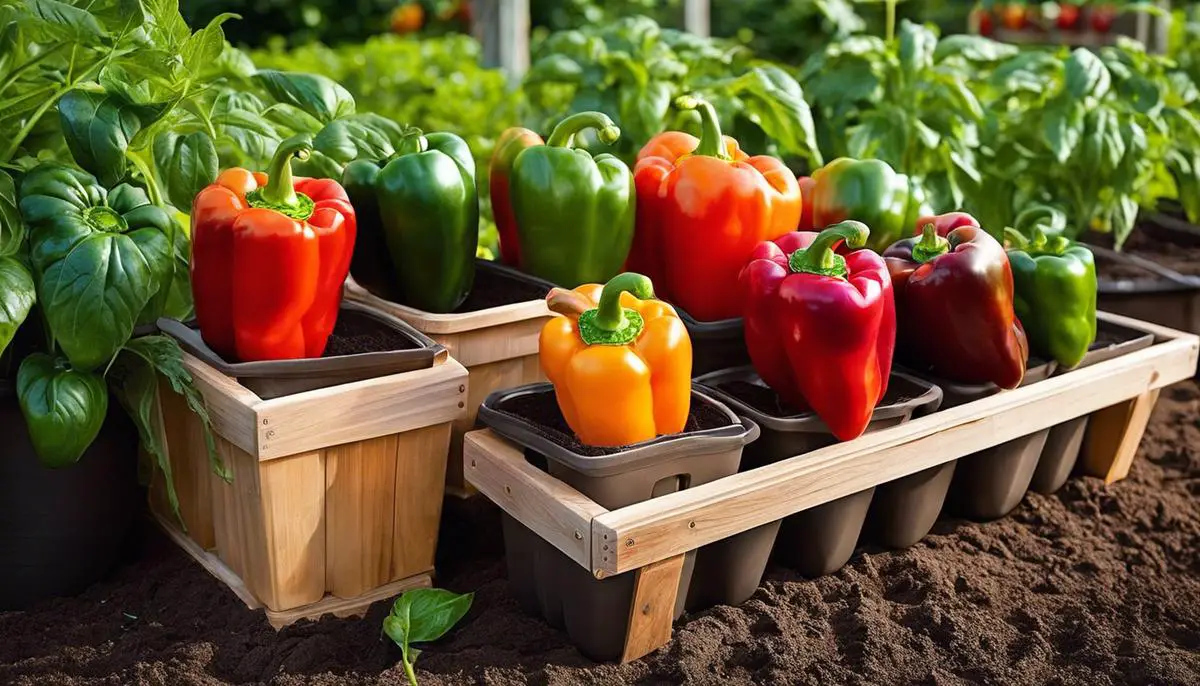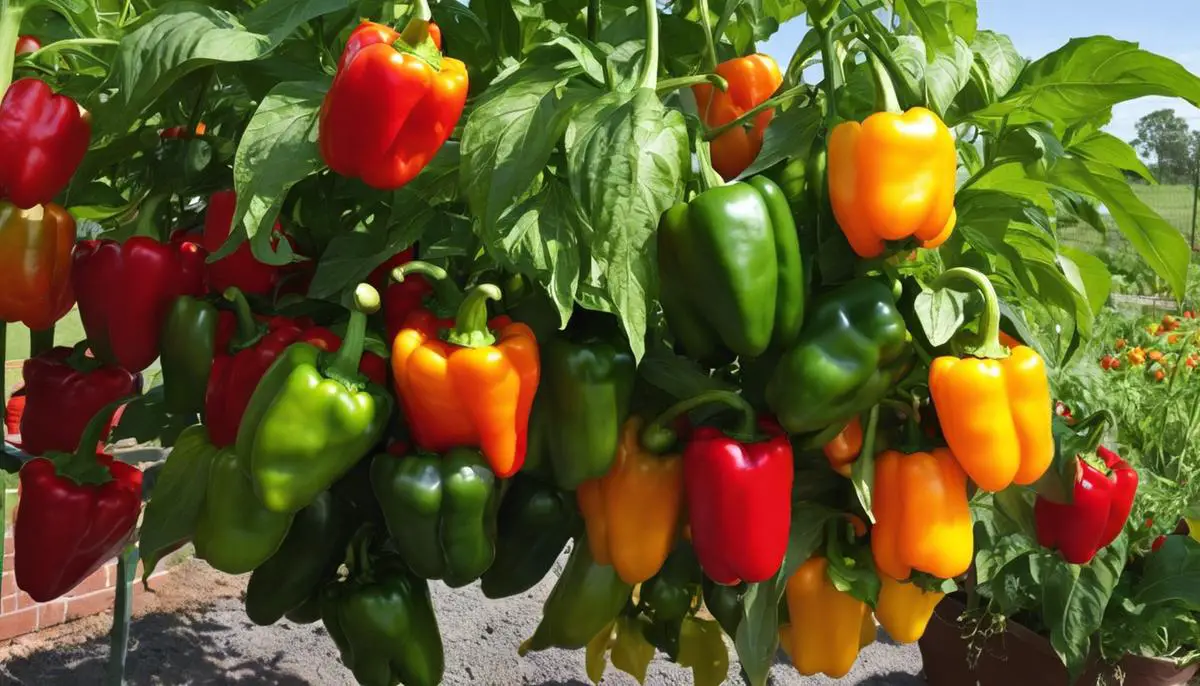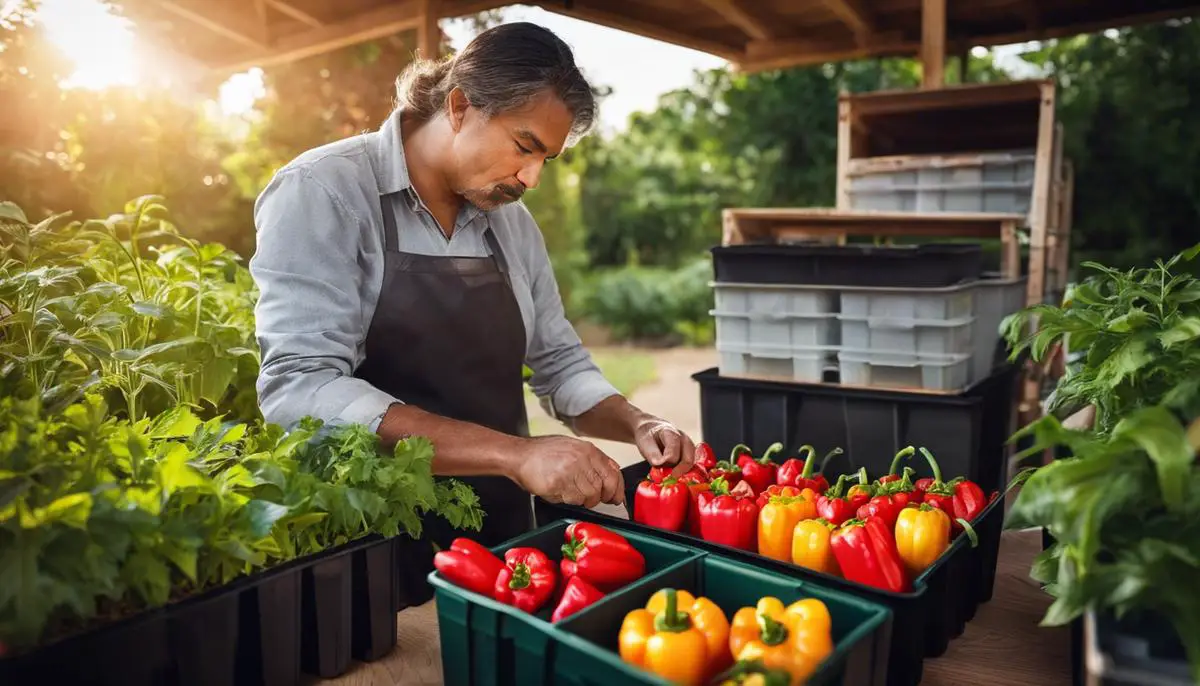Gardening offers a bounty of benefits, not just in the literal fruits of your labor but also in the therapeutic value it provides. Container gardening, in particular, has seen significant growth in popularity in recent years as a result of its versatility and adaptability. Among the many plants you can grow in containers, bell peppers stand out for their vibrant colors, delightful crisp texture, and high vitamin content. However, growing bell peppers in containers presents unique challenges and considerations. By taking a thoughtful and informed approach to elements such as container choice and preparation, proper planting methods and care schedules, as well as pest and disease management, anyone can achieve success in their bell pepper gardening endeavor.
Choosing and Preparing the Right Container
Discovering the Ideal Container Size for Thriving Bell Peppers
Every enthusiastic horticulturist knows that the secret to a thriving bell pepper garden is more than just rich soil, plenty of sunshine, and regular watering. Yes, the very foundation of successful bell pepper gardening begins with selecting the ideal container size.
Reader Poll: What online courses would interest you?
Believe it or not, the choice of container can have a massive impact on the success of bell pepper cultivation. The right size and style of the container can significantly boost the growth of the plants, resulting in an abundant harvest of juicy, brightly colored bell peppers.
So, how big should the pot be for your bell-pepper plant? If there’s one cardinal rule to remember, it’s that size definitely matters with container gardening.
Bell pepper plants have quite expansive root systems. As such, they require plenty of space to spread and grow. It is generally recommended to choose a pot that holds at least 2-3 gallons of soil. However, for optimal growth and productivity, a container with 5-gallon capacity or more is certainly ideal.
Subscribe to our newsletter!
Choosing a larger pot ensures that the pepper plants won’t become root-bound. That’s a scenario where the roots entirely fill the pot, causing a decline in growth and a disappointing yield. The extra space in larger pots provides the roots ample room to grow, thereby promoting vigorous top growth and higher yields.
Height is another essential factor to consider when selecting a container for bell pepper plants. Opting for a pot with a height of 12-14 inches is an excellent place to start. This allows for better soil depth, which gives your plant plenty of room for root development while also helping to optimize water and nutrient retention.
Last but not least, material matters. Whether it’s plastic, ceramic, or terracotta, the material of the container can influence the growth of the plants. Each material has its own advantages and trade-offs. For instance, plastic containers are lightweight and affordable but may not last as long as clay or ceramic pots. On the other hand, terracotta containers are aesthetically pleasing and durable, but they can dry out quickly in hot weather.
In conclusion, picking a container for your bell peppers is not just a one-size-fits-all situation. It depends on the needs of your plants, the available space, and your individual gardening style. Just remember that bell peppers like to spread their roots, so don’t stint on container size. Happy pepper planting!

Proper Planting and Care for Bell Peppers
Subtitle: Planting and Nurturing Your Bell Pepper Plants in Containers
Planting and nurturing bell pepper plants in optimal containers is an exhilarating hobby, and these plants provide vibrant color and zest to both your garden and plate. Once you’ve selected your preferred container, the next step is preparation and planting. And remember, this hobby thrives on patience and attention to detail, every step is important.
Begin by making drainage holes at the bottom of the container if it doesn’t already have them. Proper drainage is vital to prevent waterlogging and provides healthy root growth. A guideline is to have at least 4-6 drainage holes for a 14-16 inch container.
Then, choose a high-quality potting mix for the container, light, and well-draining but still able to hold some water. Never use plain garden soil as it often compacts in containers leading to poor drainage. A mix rich in organic matter works best. You could also incorporate a slow-release granular fertilizer into the potting mix for a nutritious start.
Now it’s time to plant your bell pepper seedlings! Gently place one seedling in the center of the pot, and cover with potting soil up to the seedling’s first set of true leaves. Planting your seedling deeply helps establish a robust root system. Water immediately until water drains from the bottom holes, it ensures the roots are adequately moistened.
For nurturing, place the container in a sunny location; bell peppers love lots of sunlight and need at least 6-8 hours per day. In less sunny areas, consider using grow lights to supplement natural light. This hobby is a fantastic way to learn about the sunshine-loving nature of these plants.
Regular watering is a must, but avoid overwatering as it could lead to root rot and other diseases. The soil should feel like a wrung-out sponge – damp but not soggy. A good rule of thumb is to water when the top inch of the soil feels dry to touch.
Feeding your bell peppers consistently is crucial. Container plants have limited soil resources, so they rely heavily on feeding. Use a water-soluble vegetable fertilizer, and follow the package instructions for the proper dosage and frequency. Organically, compost tea or fish emulsion are excellent choices.
Watch out for signs of pest and disease. Check regularly for common vegetable pests like aphids and caterpillars. Use an organic pesticide if necessary. For diseases, regular observation and early action can help save your plants.
In about 60-75 days post-transplanting, your bell peppers should be ready for harvest. You’ll know they’re ripe when they reach their expected full size and the skin is taut and shiny. Some prefer them green, while others like to wait until they are red, yellow, or orange.
You’ve now successfully navigated the journey from seedling to harvest. Elementarily, the process seems straightforward, but true mastery, as with any hobby, lies in continual learning and refinement. Each season brings unique challenges and rewards. Embrace them with curiosity, and you’ll unlock the full joy of container gardening. Happy gardening!

Pest and Disease Management
Managing pests and diseases in container bell pepper gardening can significantly impact your overall crop yield. It requires persistent observation and proactive solutions, but never fear, it’s not as daunting as it might seem!
First, we need a keen eye for the most common pests in a bell pepper container garden and these include aphids, spider mites, and thrips. Aphids are small, sap-sucking insects that can be green, black, or brown. Spider mites are super tiny spider-like creatures that create white webs on leaves, and thrips are slender, tiny bugs that cause white-to-silver patches on leaves.
Inspecting your plants on a regular basis is key in pest management- look for clusters of these pests on the undersides of leaves or along stems. But, don’t fret if you find some, there are multiple ways to counteract these pests. One eco-friendly way is to introduce beneficial insects such as ladybugs and lacewings to the container garden. They are a natural predator to these pests. Alternatively, a light application of organic insecticidal soap or neem oil can also keep the pests at bay.
On the disease’s front, the most common diseases for container bell pepper plants include bacterial spot, blossom end rot, and various types of wilts and rots. Bacterial spot appears as small, dark spots on leaves, stems, and fruits. Blossom end rot is characterized by a dark, rotten spot at the blossom end of the peppers, and wilts and rots can cause the entire plant to wilt or parts of the plant to rot.
Recognizing the early signs of these diseases can make a world of difference for the survival of your plant. Use disease-resistant bell pepper varieties if possible. Regular applications of an organic fungicide can help to prevent bacterial spot while maintaining the right balance of watering can help prevent blossom end rot and wilts and rots.
Ensure your containers have good drainage to prevent waterlogged soil – remember, waterlogged soil can lead to root rot. Rotation of crops is also a smart move as it can prevent the buildup of pathogens in the soil. If a plant does get a disease, quickly remove it to prevent the disease from spreading to other plants.
Good gardening practices like sanitation and disinfection (clean up fallen leaves and fruits, wash your hands before handling plants) can lessen the chance of disease transmission as well.
Above all, it’s about maintaining a healthy environment, one that encourages growth without inviting the bad guys. With regular monitoring, right interventions, and a bit of patience, you’ll find managing pests and diseases in container bell pepper gardening quite a breeze! Remember, the joy of harvesting your home-grown, disease-free bell peppers will be well worth your extra attention.

Whether you’re a seasoned gardener seeking a new challenge or a beginner exploring urban gardening, growing bell peppers in containers is an engaging and rewarding endeavor. It may not be a simple stroll in the park, but with the proper information about container selection, planting methods, and effective pest control, you’re empowering yourself to tackle any struggle that might come along the way. It’s a journey filled with incredible discoveries and delicious rewards. So, stake out your container, fetch your gardening tools, and embark on an exciting journey of container bell pepper gardening. The rewards are well worth the effort, both for your palate and your well-being.

